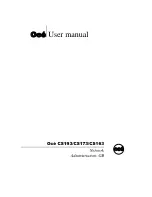
1
1-22
About the Command WorkStation (Option)
Newly printed jobs are added to the Printed queue, and are shown at the top of the list.
Jobs are saved in the Printed queue until the job limit is reached. When the first job
over the limit is printed, the oldest job is deleted from the disk. The value for Jobs
Saved in Printed Queue can be changed in Setup by the administrator.
N
OTE
:
If you reprint a job in the Printed queue, the job returns to its original position
in the Printed queue after it is printed.
While it is printing, a job consists of PostScript or PCL and raster data. The raster data
in RAM is not cleared until memory is needed to rasterize the next job. As long as the
raster data is intact, the job can be reprinted from the Printed queue. Printed jobs that
still have their raster data are represented by a white raster icon in the Printed queue
(icon 2 in the previous table); jobs with only PostScript or PCL data remaining are
represented by a white PS icon (icon 1). If the job was printed from a held raster job
(in the RIP area), the raster data in the RIP area remains and can be used to reprint the
job after the raster data has been cleared from the Printed queue.
Job commands
Job commands are used to assign a selected job to a new destination or process. These
commands are available from the Job menu (see page 1-9). Many are also available as
right-mouse commands (described following the list of commands below). The job
commands available at a given time depend on the context; unavailable commands are
dimmed. Job commands are available in the Queues, Archive, and FreeForm windows.
The job commands available for selected jobs in the Queues, Archive, and FreeForm
windows are listed in the following table. The table also describes the effect of each
command on raster data associated with the affected job(s).
Choose this:
To do this:
Raster data is:
Delete
Delete the job(s).
Deleted
Duplicate
Duplicate one or more selected PostScript,
PCL, or PDF data jobs in the Spool or Print
areas. You can use the duplicate job(s) for
different print options or a different
destination. (The Duplicate command
actually creates a reference to the original
job, with the same name).
n/a
(The Duplicate command is not available
for raster jobs)




































